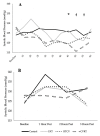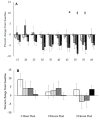Post Exercise Hypotension Following Concurrent Exercise: Does Order of Exercise Modality Matter?
- PMID: 32148614
- PMCID: PMC7039488
- DOI: 10.70252/CVKN8623
Post Exercise Hypotension Following Concurrent Exercise: Does Order of Exercise Modality Matter?
Abstract
Cardiovascular (CV) and resistance training (RT) can moderate negative effects of aging, disease, and inactivity. Post-exercise hypotension (PEH) has been used as a non-pharmacological means to control and reduce BP. Few have evaluated PEH response following a bout of exercise combining CV and RT, whether or not there is an order effect, or if PEH continues when activities of daily living (ADLs) are resumed. Participants (N = 10) completed a non-exercise control, a graded exercise test (GXT), and two concurrent sessions (CVRT and RTCV). Each session was followed by a 60-minute laboratory and 3-hour ADLs PEH assessment, respectively. Two-way and Welch-one-way repeated measures ANOVAs were used to determine differences between among conditions in PEH. There was a significant interaction between BP and condition following the 60-minute laboratory measure (p = .030, ηp 2 = .166) and the ADLs BP assessments (p = .008, ηp 2 = .993), respectively. PEH occurred following concurrent exercise conditions at minute 45 for RTCV (118 ± 8, p = .041; 95% CI [0.223, 17.443]) and minutes 50 (117 ± 9; p = .036 95% CI [0.441, 21.097]) and 55 (118 + 8; p < .001; 95% CI [5.884, 14.731]) following CVRT. BP was elevated during ADLs following the control session compared to the GXT, RTCV, and CVRT. Regardless of the order, concurrent exercise is effective in potentiating PEH. Elevation in BP associated with ADLs can be mitigated if exercise is performed previously.
Keywords: Exercise prescription; accelerometry; cardiovascular health; physical activity; resistance training.
Figures




Similar articles
-
Reliability and Time Course of Postexercise Hypotension during Exercise Training among Adults with Hypertension.J Cardiovasc Dev Dis. 2024 Jan 29;11(2):42. doi: 10.3390/jcdd11020042. J Cardiovasc Dev Dis. 2024. PMID: 38392256 Free PMC article.
-
A comparison of the immediate effects of resistance, aerobic, and concurrent exercise on postexercise hypotension.J Strength Cond Res. 2011 May;25(5):1429-36. doi: 10.1519/JSC.0b013e3181d6d968. J Strength Cond Res. 2011. PMID: 21358433
-
Evaluating the Methodological Quality of Postexercise Hypotension Aerobic Exercise Interventions.Front Physiol. 2022 Mar 10;13:851950. doi: 10.3389/fphys.2022.851950. eCollection 2022. Front Physiol. 2022. PMID: 35360233 Free PMC article.
-
Effects of concurrent and aerobic exercises on postexercise hypotension in elderly hypertensive men.Exp Gerontol. 2017 Nov;98:1-7. doi: 10.1016/j.exger.2017.08.012. Epub 2017 Aug 10. Exp Gerontol. 2017. PMID: 28804048 Clinical Trial.
-
Post-exercise Hypotension Following a Single Bout of High Intensity Interval Exercise vs. a Single Bout of Moderate Intensity Continuous Exercise in Adults With or Without Hypertension: A Systematic Review and Meta-Analysis of Randomized Clinical Trials.Front Physiol. 2021 Jun 28;12:675289. doi: 10.3389/fphys.2021.675289. eCollection 2021. Front Physiol. 2021. PMID: 34262474 Free PMC article.
Cited by
-
No Decrease in Blood Pressure After an Acute Bout of Intermittent Hyperpnea and Hypoxia in Prehypertensive Elderly.Front Physiol. 2020 Oct 2;11:556220. doi: 10.3389/fphys.2020.556220. eCollection 2020. Front Physiol. 2020. PMID: 33123023 Free PMC article.
References
-
- American College of Sports Medicine. ACSM’s guidelines for exercise testing and prescription. 10th edn. Baltimore: Lippincott, Williams and Wilkins; 2018.
-
- Barrett-O’Keefe Z, Kaplon RE, Halliwill JR. Sustained postexercise vasodilation and histamine receptor activation following small muscle mass exercise in humans. Exp Physiol. 2012;98:268–277. - PubMed
-
- Dujic Z, Ivancev V, Valic Z, Bakovic D, Marinovic-Terzic I, Eterovic D, Wisloff U. Postexercise hypotension in moderately trained athletes after maximal exercise. Med Sci Sports and Exerc. 2006;38(2):318–322. - PubMed
-
- Eicher JD, Maresh CM, Tsongalis GJ, Thompson PD, Pescatello LS. The additive blood pressure lowering effects of exercise intensity on post-exercise hypotension. Amer Heart J. 2010;160(3):513–520. - PubMed
LinkOut - more resources
Full Text Sources
